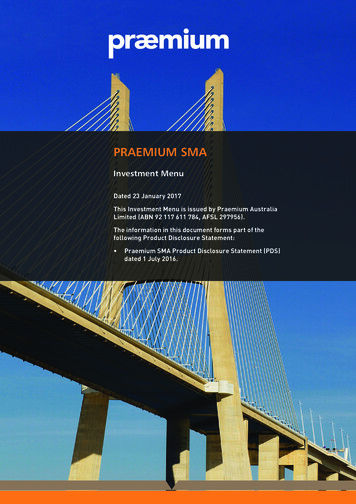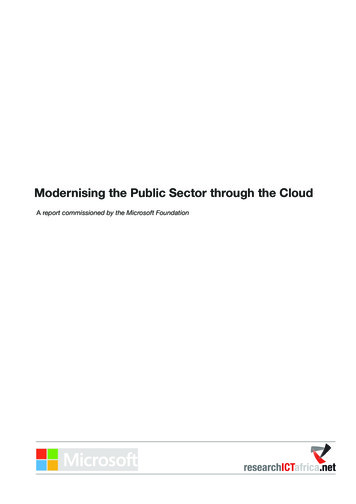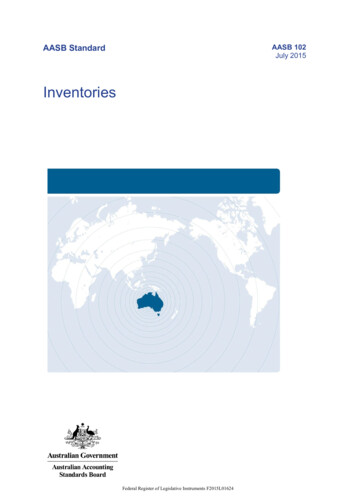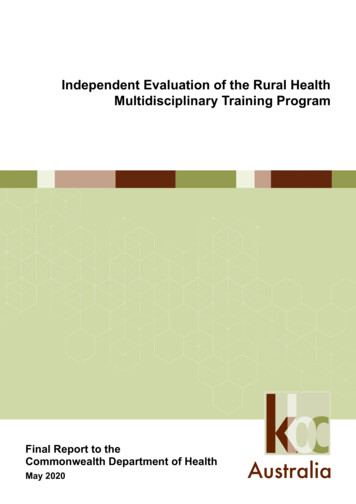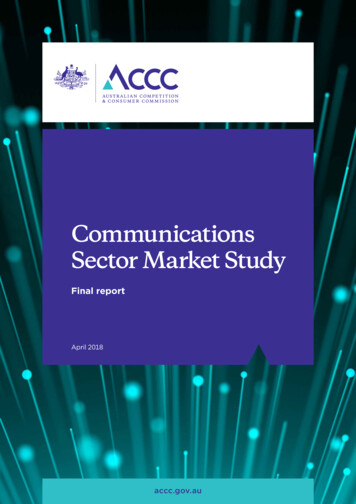
Transcription
CommunicationsSector Market StudyFinal reportApril 2018accc.gov.au
ACCC communications sector marketstudy final reportConsumers are getting better value, but there is considerable concentration in keyservice markets.MOBILE PHONENBN3.1%4.5%real decline inprices in 2016-1749%in data quotas in2016-1789%of services suppliedby three providers in 2017real decline in pricesin 2016-1724%in data quotas in2016-1794%of services suppliedby four providers in 2017The NBN is more than half way through its rollout however for some consumer segmentswireless may increasingly be a viable substitute.AVAILABLITYPOTENTIAL SUBSTITUTESNBN availableto 6.3 millionpremises with 3.6million activationsby March 2018100GB Regional Australianshave been among thefirst to benefit from theNBN with 56% ofactivations in regionalAustralia30%Download quotas onsome wireless plans havereached over 100GBof fixed broadbandsubscribers would considerswitching to a wirelessservice
Some immediate NBN issues are being tackled. NBN 50Mbpsand CVCcapacity pricepromotionACCC inquiry intoNBN wholesaleservice standardsACMA imposingrules to improveNBN consumerexperience37% increase in CVCbetween September andDecember 2017There is rapid growth and development of emerging services and also some potentialissues to monitor.80% ofbusinesses usedcloud computingin 2016Over 1bAustralian datacentre marketin 2017OTT services continuing totransform use of communicationsnetworks and disrupt marketsIndustry predictscontent deliverynetworks will carryapproximately 70%of all traffic by 2021Industry predictsthe Internet ofThings will providesignificant uplift toGDP by 2025While e-SIMs may increasecompetition between mobileservice providers there may bebarriers for smaller providers inoffering e-SIM devicesFixed and wireless networks will continue to evolve, influenced by technology, newservices, consumer preferences and government policy.NBNINCREASING CONVERGENCEWIRELESSWirelessPotential for NBN tobe split intocompeting networksFixed5G
ivCommunications Sector Market Study—Final report
ContentsGlossaryvi1. Executive summary1.1 Communications sector market study1.2 Key points1.3 State of competition in the supply of broadband and voice services1.4 Transitioning consumers to the NBN1.5 Medium term NBN issues1.6 Key intermediate inputs1.7 Network competition and convergence1.8 Emerging services and issues1.9 Policy implications and priorities11255667782. Recommendations and ACCC actions2.1 Recommendations2.2 ACCC actions99103. Introduction3.1 The market study3.2 The communications sector1313154. Current state of competition in communications services4.1 Broadband, voice and messaging services4.2 Network technologies4.3 Aggregation services4.4 Transmission and dark fibre services4.5 Internet interconnection4.6 Data centres4.7 Content delivery networks4.8 Over-the-top content services4.9 Cloud computing4.10 Internet of Things20204453637176798083875. Immediate issues requiring action to promote competition5.1 NBN wholesale access prices5.2 NBN wholesale services standards5.3 Critical wholesale inputs for the supply of fixed line broadband services5.4 Consumer choice and information91911041071196. Issues requiring monitoring and potential future action6.1 Competition between network technologies6.2 Potential competition concerns in relation to newer communications services1411411507. Policy implications and priorities7.1 Current regulatory and competition arrangements7.2 Market structure evolution—NBN disaggregation7.3 Spectrum management7.4 Data availability and use: a new Consumer Data Right7.5 Mobile Black Spot Program7.6 Regional Broadband Scheme155155156158161162163Appendix A165Appendix BPotential future scenarios for the Australian communications sector166166Communications Sector Market Study—Final reportv
Glossaryvi3G3rd generation mobile communications technology4G4th generation mobile communications technology5G5th generation mobile communications technologyACCANAustralian Communications Consumer Action NetworkACCCAustralian Competition and Consumer CommissionAccess seekersTelecommunications companies that seek access to declared services (thatis, the right to use the declared service)ACLAustralian Consumer LawACMAAustralian Communications and Media AuthorityADSLAsymmetric digital subscriber lineARPUAverage revenue per userAVCAccess Virtual CircuitAVODAdvertisement funded video on demandB2BBusiness to businessBPMRBroadband performance monitoring and reporting programCCACompetition and Consumer Act 2010 (Cth)CDNContent delivery networkCISCritical Information SummaryCLICaller Line IdentificationCSGCustomer Service GuaranteeCVCConnectivity Virtual CircuitDark fibreUncontended, unlit point-to-point fibre optic cable that requires connectingequipment and management system to supply a transmission serviceData centre co-locationserviceData centre where a business can rent space for servers and other hardwareand connect them to network service providersDBDRDimension Based Discount for service providersDSLAMDigital Subscriber Line Access MultiplexerDTCSDomestic transmission capacity serviceESAsExchange Service AreasFABFibre Access BroadbandFTAFree-to-airFTTBFibre to the buildingFTTCFibre to the curbFTTNFibre to the nodeFTTPFibre to the premiseFTTxFibre to the x, where ‘x’ refers to any or all of the aboveGbpsGigabits per secondGHzGigahertzHFCHybrid Fibre CoaxialHHIHerfindahl-Hirschman IndexIaaSInfrastructure as a ServiceCommunications Sector Market Study—Final report
IoTInternet of ThingsIoTAAIoT Alliance AustraliaIPInternet ProtocolIPTVInternet Protocol televisionISPInternet service providerIXPsInternet exchange pointsLayer 2The data link layer of the open systems interconnection model. The data linklayer provides a connection between two fixed end points in a network tofacilitate the transmission of data traffic.Layer 3The network layer of the open systems interconnection model. The networklayer provides a switching function that enables the routing of traffic to itsdestination address.LPWALow-power wide-area, a wireless telecommunications technology that allowsa low bit rate signal to be transmitted over a large areaLSSLine Sharing ServiceLTIELong-term interests of end usersM2MMachine to machineMbpsMegabits per secondMNOMobile network operatorMVNOMobile virtual network operatorNBNNational Broadband NetworkNBN CoNBN Co LimitedNNINetwork to Network InterfaceOECDOrganisation for Economic Cooperation and DevelopmentOfcomOffice of Communications, UK communications regulatorOTTOver-the-top content/servicesPaaSPlatform as a ServicePOIPoint of InterconnectionPOPPoint of PresenceRBSRegional Broadband SchemeRKRRecord keeping rule—under s. 151BU of the CCA, the ACCC has the powerto make an RKR and require that carriers and carriage service providerscomply with it. The rules may specify what records are kept, how reports areprepared and when these reports are provided to the ACCC.SaaSSoftware as a ServiceSAUSpecial Access UndertakingSBASSuperfast Broadband Access ServiceSMSShort Message ServiceSTVSubscription TVSVODSubscription video on demandTC1NBN Traffic Class 1—highest priority, dedicated capacity traffic class, suitablefor voiceTC2NBN Traffic Class 2—business grade traffic class used for delivering highspeed symmetrical internet (supports video conferencing, IPTV, gaming)Communications Sector Market Study—Final reportvii
viiiTC3NBN Traffic Class 3—designed to give priority to transactional data such asbusiness applications running on WANTC4NBN Traffic Class 4—standard, best efforts traffic class used for deliveringresidential and small business broadband servicesTCP CodeTelecommunications Consumer Protections CodeTCPSS ActTelecommunications (Consumer Protection and Service Standards) Act 1999(Cth)Tier 1 service providerLarge service providers who are vertically integrated and supply wholesaleand retail NBN servicesTier 2 service providerService providers that intend to directly connect to the NBN and are usingNBN wholesale aggregation services prior to reaching the scale at which thisis commercially viableTier 3 service providerService providers that do not intend to directly connect to the NBN and willuse NBN wholesale aggregation services on an ongoing basisTIOTelecommunications Industry OmbudsmanTTOVTelstra, TPG, Optus, VerizonTVODTransactional video on demandULLSUnconditioned Local Loop ServiceUNI-VUser Network Interface—Voice, connects the user voice interface to the voicenetwork over the NBNUSOTelecommunications Universal Service ObligationVoIPVoice over Internet ProtocolWANWide Area NetworkWBAWholesale Broadband AgreementWiMAXWorldwide interoperability for Microwave AccessWLRWholesale Line RentalCommunications Sector Market Study—Final report
1.Executive summary1.1Communications sector market studyWe have undertaken this market study at a time of significant change in the Australian communicationssector. We noted at the start of the inquiry that the sector is subject to rapid changes in technology,product innovation and consumer preferences as well as major structural change as we transitionto the NBN (National Broadband Network). We set out to assess the implications of these trendsfor the state of competition in the supply of communications services, to examine any identifiedcompetition or consumer concerns and to identify actions needed to ensure regulation is responsiveto the requirements of the changing communications landscape. This includes ensuring that over thelonger-term, innovation and investment are not stifled, competition is encouraged and the interests ofconsumers are well served.Evidence of this rapid pace of change is the extent of developments we have witnessed since wereleased our Draft Report in October 2017. At that time, the NBN rollout was approaching its mid-pointand a lot of attention was being directed at consumers’ experience during the migration from legacyservices and with the services supplied to them over the NBN. We are encouraged that since that time,there have been a number of actions taken by Government, regulators and industry to address some ofthe immediate issues of concern about services provided over the NBN identified in our Draft Report.It is important that the problems that have emerged during the current state of transition of theAustralian communications sector are quickly resolved. This is because communications services arethe key foundation for the digital transformation of the economy and the productivity, innovationand efficiency gains that it will bring. In addition, they are essential for all Australians to undertakedaily activities, including maintaining contact with family and friends, and accessing commercial,government, medical and education services.The Australian Competition and Consumer Commission (ACCC) uses market studies as a toolto improve our understanding of specific sectors and to help promote effective competition inmarkets. We undertook this market study to provide a wide-ranging stocktake of how Australiancommunications markets are evolving in the face of recent and prospective changes.We have considered the state of competition in the supply of retail communications services toindividual, residential and small business consumers and also in the markets for intermediate inputs andother wholesale services. Figure 1.1 depicts a generalised communications supply chain and illustratesthe coverage of the market study.Communications Sector Market Study—Final report1
Figure 1.1:The communications supply chain—how voice and broadband services are delivered toconsumers over next generation networksAggregation servicesConsumerservicesAccess network servicesTransmission anddark fibre servicesService provider (SP) networksSatellitePeoplePOPs & corenetworkFixedPOIThe internetSP data centreswith voice,messaging,video and otherapplicationservicesPeeringTransitTHE INTERNETPremisesPOPs & corenetworkIoT DevicesData centreswith OTT, cloudcomputing ignificant change is affecting how this communications supply chain functions, including the natureand extent of competition in retail and wholesale markets. This change includes both structural reform,as a result of policy initiatives (at the centre of which is the rollout of the NBN) and the rapid pace oftechnological advancement and product innovation that is occurring globally.We have taken a five year horizon for considering likely competition and efficiency developmentsin communications markets. This time period covers the completion of the NBN rollout, theexpected initial deployment of 5G wireless technology and settling of the future market structurefor the wholesale provision of fixed broadband services as part of NBN Co Limited (NBN Co)’seventual privatisation.Reflecting the dynamic nature of communications markets, the period of the study has allowed us toobserve developments that have occurred in parallel including those prompted by some of the findingsand proposed recommendations in our Draft Report. We recognise that this report captures a snapshotof the communications sector at this point in time and that the markets we have assessed will continueto evolve, sometimes in ways that may not be foreseen. However, we consider that the regulatory toolswe have equip us to respond to changing market circumstances, address any market failure, promotecompetition, and benefit consumers.1.2Key points1.2.1Competition and the regulatory frameworkNotwithstanding considerable concentration in both fixed and mobile retail markets, there is evidenceof competition between the major service providers of broadband and voice services. Smaller providersand new entrants have the potential to provide additional competitive tension by exercising someconstraint on the larger providers.We have not found any major deficiencies in the current communications regulatory arrangements thatwe administer and consider that these have remained largely fit for purpose. In our view, the economicregulatory framework for the communications sector has proven to be capable of accommodatingmajor changes to the sector, including allowing for appropriate responses during the transition tothe NBN. In particular, we consider that Part XIC of the Competition and Consumer Act 2010 (CCA)2Communications Sector Market Study—Final report
provides the necessary tools for access regulation of monopoly and bottleneck communicationsinfrastructure, including that being built by NBN Co, and we do not find that there is currently a needfor significant changes to this regulatory regime.We consider that it is important that regulatory conditions do not stifle innovation and flexibility inemerging and developing markets. We consider there is far less need for up-front regulation of newercommunications services. Looking further ahead, if competition concerns arise in relation to theprovision of these services, we would address these concerns in the first instance through use of thegeneral competition law provisions in the CCA.1.2.2Progress on NBN issuesThe rollout of the NBN is a major investment in communications infrastructure and is having asignificant impact on the Australian communications sector. The changes within the supply chain andconsequential impacts on retail service providers and consumers have inevitably been a key focus of themarket study.The NBN rollout is now well advanced with over three and a half million premises activated and NBN Coprogressing at a rapid pace to complete its build by 2020.However, a number of competition and consumer issues related to the NBN transition have emergedand require immediate measures to resolve on the part of both retail service providers and NBN Co.Some of these measures are already underway with significant progress achieved since the publicationof our Draft Report in October 2017.We are taking actions to promote improved consumer and competition outcomes by ensuringavailability of reliable and useful information to support consumer choice. These measures includeenforcement of the Australian Consumer Law (ACL) including obtaining court-enforceable undertakingsand compensation from Telstra, Optus, TPG, iiNet, Internode, M2 Commander, Dodo and PrimusCommunications (iPrimus) for likely misleading consumers about maximum speeds they could achieveon certain NBN services. In response to our concerns, these service providers have undertaken that,where they advertise or otherwise represent to potential customers that they will receive a particularspeed, they will check each customer’s attainable speed within four weeks of connecting a new service.If it is below the advertised speed, they will notify the customer and offer remedies.We have also undertaken measures to promote improved broadband speed information available toconsumers for the NBN plans that service providers offer, including: our broadband speed claims guidance for service providers released in August 2017, which has led anumber of service providers to improve their marketing information and give consumers comparableinformation about typical busy period broadband speeds,1 and the introduction of our broadband performance monitoring and reporting program (MeasuringBroadband Australia), which released its first report in March 2018.In addition, we have commenced an inquiry into NBN Co’s Wholesale Service Standards, in linewith our proposed Action 6 of the Draft Report. This inquiry is looking at aspects of the NBN Cowholesale arrangements most likely to influence consumer experience and whether the service levelscurrently in place are appropriate and effective. As part of the inquiry, we will examine whether thereare appropriate incentives for NBN Co to remedy service failures and consider the adequacy ofcompensation available to service providers to enable them to provide appropriate consumer redress.Since the release of our Draft Report, the Government has also announced a range of new protectionsto ensure broadband customers get the level of service they expect from their retail service provider asthey transition to the NBN. These include the Australian Communications and Media Authority (ACMA)implementing new rules that will: specify the minimum information that service providers must provide about their network servicesbefore they sign consumers up specify minimum standards for service providers’ complaints-handling processes and a requirementfor them to report their complaint numbers to the ACMA so that changes can be monitored1We note, however, that some service providers accounting for approximately 16 per cent of the market are yet to provide typicalbusy period speeds information in their advertising.Communications Sector Market Study—Final report3
require service providers to undertake a series of tests after a consumer has activated their NBNservice to ensure that the service works and that faults are identified early require carriers and carriage service providers to provide continuity of voice and/or internet servicesif consumers experience issues when migrating to the NBN.NBN Co itself has undertaken a number of initiatives that address some of the issues identified in ourDraft Report. Notable among these are its new temporary prices to promote the 50 Mbps access virtualcircuit (AVC) tier and to increase the amount of connectivity virtual circuit (CVC) capacity provisionedper customer.2Many service providers have responded positively to the various ACCC and NBN Co initiatives, andadjusted their wholesale acquisitions and retail products, resulting in significant increases in CVCcapacity contracted. Evidence of this is a 37 per cent increase in CVC capacity acquired per customerbetween the end of September and December 2017.3 This has already led to a dramatic reduction incongestion on the network and should result in fewer speed complaints.NBN Co’s temporary prices mean that service providers and their customers are effectively gettingincreased data speeds at no (or limited) extra charge. Consumer willingness to pay additional chargesfor increased data speeds remains uncertain, and we are concerned that NBN Co’s longer-term targetsmay continue to create excessive uncertainty for access seekers. Further, achievement of efficientpricing outcomes will be constrained if demand for NBN services does not increase at the rate currentlyexpected by NBN Co in the next few years.1.2.3Wireless and 5G5G deployment could create significant opportunities for industry and consumers. However, at this earlystage, there is still uncertainty about the nature and timing of the deployment but it is anticipated that5G has the potential to accelerate the extent of fixed to wireless broadband substitution given its abilityto provide comparable speeds to fixed broadband services. In doing so, existing business models maybe disrupted, with the degree of substitution in part depending on the price and service performance ofNBN services.Future substitution will also depend on the nature of wireless service offerings from providers, whichare not yet evident. Although the amount of data included for wireless offerings has been growing, ingeneral, it is still typically less than 200 GB per month, while recent trends mean that most fixed lineservices now include unlimited data. If this divergence between data quotas continues in the future, itmay limit the substitutability of wireless for fixed line broadband for most consumers.1.2.4Changes to proposed actions and recommendationsOur Draft Report put forward a number of proposed recommendations and actions. Feedback fromsubmissions to the Draft Report has assisted us to confirm which areas of the sector require regulatoryattention, and which do not.Following consideration of submissions to the Draft Report, we have made a number of changes to ourfindings, actions and recommendations: On NBN pricing issues and cost recovery obligations our Final Report takes into account NBN Co’srecent pricing initiatives, which have demonstrated NBN Co’s ability to respond flexibly tostakeholder concerns. We have pointed to the importance of examining the potential for disaggregation of NBN Co prior toits privatisation as a means of facilitating greater infrastructure-based competition. In response to concerns about the potential for deterring investment at this nascent stage ofdeployment, we have decided to keep a watching brief on the deployment of dense small cellinfrastructure to identify any potential barriers impeding access to critical infrastructure.234Service providers acquire AVCs at a specified speed tier for each customer premises they supply over the NBN. They must also buyCVC capacity from NBN Co to carry aggregated customer traffic to the points that their networks interconnect with the NBN.Australian Competition and Consumer Commission (ACCC), NBN retailers acquired 37% more CVC, ACCC, 8 February 2018,viewed 19 March 2018.Communications Sector Market Study—Final report
In relation to e-SIMs, we will explore broader concerns that competition between mobile serviceproviders in the offering and use of e-SIM devices could potentially be impeded by the need to entercommercial agreements with device manufacturers. We propose to await the findings of the ACMA’s research on email portability before decidingwhether to undertake any further review of email retention offerings.1.3State of competition in the supply of broadband andvoice servicesBroadband and voice services are the essential communications services on which individuals andbusinesses rely. The retail provision of these services displays considerable concentration, with thefour largest providers accounting for 96 per cent of services to residential premises. Telstra’s fixedline dominance has not been significantly eroded so far in the transition to the NBN despite somelosses in regional areas where its dominance has been greatest. Competition for mobile services isconcentrated in the hands of the three mobile network operators (MNOs) that account for 91 per centof mobile services.However, we anticipate that the competitive dynamic in the supply of fixed line and mobile voice andbroadband services will increase following the recent entry of Vodafone into the provision of fixedline services and TPG’s deployment of its own wireless network. This will result in four major carriersproviding both fixed and mobile services, and potentially five major fixed line providers.Notwithstanding the high level of market concentration, there is evidence of competition in the marketsfor voice and broadband services, over both fixed and mobile access technologies. This is particularlyevident in the price competition between suppliers of both fixed and mobile services. However, theextent of non-price competition is greater in mobile, compared to fixed services as evidenced bysignificant product differentiation in mobile services. While there has been less differentiation in fixedservices we note that competition in relation to quality of service dimensions, such as broadband speedis beginning to emerge, including as a result of our recent guidance on speed claims.While there are signs of retail price competition occurring for fixed services, as noted above we initiallyheard from many service providers that the NBN wholesale pricing construct and level was constrainingtheir ability to provision greater capacity given consumers’ current willingness to pay. More recently,NBN Co has begun to respond to stakeholder feedback by introducing temporary pricing initiatives andis consulting with industry on longer-term pricing changes. The temporary pricing has already benefitedconsumers through enabling better quality broadband with less congestion during peak eveningperiods. However, it will be important that the long-term pricing changes also successfully addressthese issues.1.4Transitioning consumers to the NBNThe challenges faced by NBN Co include providing services that meet consumer expectations anddeliver an efficient use of the infrastructure being deployed while simultaneously completing the build.While the NBN experience of the majority of consumers is generally positive, there is a significantnumber of consumers for whom this is not the case who have reported unsatisfactory experience withthe NBN both during and after migration from the legacy networks. Two principal concerns arise in thisregard: issues faced by consumers during the migration of their services from legacy networks to theNBN, and the performance of services provided over the NBN not meeting consumer expectations.As noted above, we have commenced an inquiry into NBN wholesale service standards. This inquiry isexamining concerns about connection and activation problems at the time of migration as well as faultrectification after connection, missed appointments and unsatisfactory complaint resolution processes.We will determine whether existing wholesale service standards are appropriate and consider whetherregulation is necessary to improve customer experience. Concurrently, the ACMA is undertakingcomplementary work to implement a range of new rules requiring service providers to improve thecustomer experience in moving to the NBN, which are expected to come into place in mid-2018.Communications Sector Market Study—Final report5
In relation to the second concern, the adoption of our speed claims guidance by service providers is animportant positive step towards addressing consumer dissatisfaction with the speed of NBN services.The positive response by a number of service providers is resulting in the provision of improved retailplan information on speeds that supports consumers in making their purchase decisions, and throughretailers ensuring their retail NBN services typically operate in the manner advertised.Recent pricing and product development initiatives by NBN Co are encouraging the uptake andpromotion of higher speed services by service providers. We expect this to result in higher servicequality and improved consumer experience.1.5Medium term NBN issuesWhile the above measures are likely to lead to significant progress on improving consumer experience,it will take more time for the full effects to be evident. We acknowledge that these and proposed futuremeasures may not resolve all of the poor outcomes that are being delivered by retail markets.We welcome recent initiatives by NBN Co to work with stakeholders on these issues, for example, theflexibility shown by NBN Co in its new prices to promote the 50 Mbps wholesale tier and to increase theamount of CVC provisioned per service. These pricing initiatives implemented in December 2017 aretemporary measures and we also note that NBN Co is to introduce longer-term pricing changes.However, notwithstanding these developments, the willingness to pay additional charges for increasedthroughput remains uncertain, and we are concerned that NBN Co may continue to have difficultymeeting its financial targets. If demand for NBN services does not increase at the rate currentlyexpected by NBN Co, this may continue to create uncertainty for access seekers and has the potentialto constrain the delivery of efficient pricing of the NBN infrastructure.While there remain longer-term pricing issues to resolve, we provided additional flexibility to the partiesin negotiating pricing outcomes, through deferring our decision on the Special Access Undertaking(SAU) variation that NBN Co has submitted. NBN Co’s proposed SAU variation incorporates fibre to thenode (FTTN), fibre to the building (FTTB) and hybrid fibre coaxial (HFC) access technologies into theSAU, to reflect the current NBN model. If approved, the SAU variation would extend the current SAUpricing arrangements to these access technologies. We anticipate resuming our assessment of the SAUvariation when NBN Co has determined its longer-term pricing changes.The multiple and complex objectives tha
2016-17 24% in data quotas in 2016-17 49% real decline in prices in 2016-17 4.5% real decline in prices in 2016-17 3.1% 30% of fixed broadband subscribers would consider switching to a wireless service 100GB Download quotas on some wireless plans have reached over 100GB NBN available to 6.3 million premises with 3.6 million activations by .
